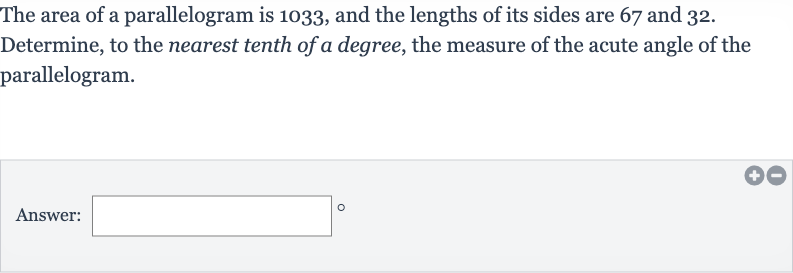AI tutor
Welcome to Bytelearn!
Let’s check out your problem:

The area of a parallelogram is , and the lengths of its sides are and . Determine, to the nearest tenth of a degree, the measure of the acute angle of the parallelogram.Answer:
Full solution
Q. The area of a parallelogram is , and the lengths of its sides are and . Determine, to the nearest tenth of a degree, the measure of the acute angle of the parallelogram.Answer:
- Identify Formula: To find the acute angle of the parallelogram, we need to use the formula for the area of a parallelogram, which is . Here, the base can be either side of the parallelogram, and the height is the perpendicular distance from the base to the opposite side. We can consider one of the given side lengths as the base and the other as the product of the other side and the sine of the acute angle between them.
- Choose Base and Height: Let's choose the longer side, , as the base. Then the height can be represented as , where is the acute angle we are trying to find. The area of the parallelogram is given as , so we can set up the equation .
- Set Up Equation: Now, we solve for . Dividing both sides of the equation by , we get .
- Solve for : Calculating the right side of the equation, we have .
- Calculate To find the angle , we take the inverse sine (arcsin) of . Using a calculator, we find .
- Find Angle : Calculating the , we get degrees to the nearest tenth of a degree.
More problems from Find trigonometric ratios using the unit circle
QuestionGet tutor help
QuestionGet tutor help
QuestionGet tutor help
QuestionGet tutor help
QuestionGet tutor help
QuestionGet tutor help
Question
. Find the value of in degrees.Write your answer in simplified, rationalized form. Do not round.____
Get tutor helpQuestionGet tutor help
